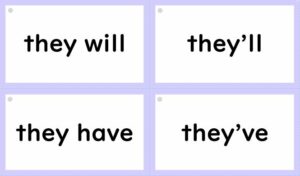Contractions in English Communication – Introduction
We all use some form of contraction in our daily lives. For example, when we say “I can’t afford it” or “I’m going out” – these phrases are using contractions.
They make our speech sound natural and help us communicate faster. But do you know how to wield this linguistic magic wand?
In this article, we’ll demystify contractions, explore their secrets and equip you with the skills to use them confidently.
What does contraction mean in English?
Contractions are a shortened form of two words, usually an auxiliary verb and its subject or object. They can also be used to replace parts of speech such as ‘will’ and ‘would’.
Let’s look at some examples.
- I’ll go. (I will go.)
- You’re right. (You are right.)
As you can see, the apostrophe (‘) is used in place of one or more letters. This is an important point – it’s not one apostrophe per missing letter, but one in place of one or more letters.
Some contractions are very common in spoken English because it’s easier for people to say them quickly and sound natural than those with longer words like ‘will’ and ‘would’. If you have trouble with these short forms, try saying them aloud first.
In informal writing, contractions are often used to make your writing more personal or casual by using shorter words and phrases that express the meaning of the full sentence without using all of its parts (like “I’m” or “you’re“).
Why do we use contractions in English?
We use contractions in English communication speed up writing and speaking (mainly speaking, though), so that we can concentrate on the important words in a sentence.
For example, “I’ll help you with your homework”. The important part is the help with the homework and using a contraction gets us there faster.
It is worth noting that contractions make speaking easier and quicker.
In the above example, I will was abbreviated to I’ll. What about the negative of this?
One option is not say I’ll not, which is certainly an option. The more common approach is to contract the will not part. However, willn’t doesn’t roll off the tongue so easily, so instead, we contract will not to won’t. This contraction is extremely common in English and it’s something that will feel natural very quickly.
When do you not use contractions in English?
In addition to speaking, another common way to use contractions is in informal writing. Contractions are only used when you want to sound more casual and relaxed, such as when you’re writing a social media post or an email to a friend. You also may use them when speaking informally on the phone with friends and family members, but less so in formal situations (such as at work).
If you’re writing something formal and professional – such as a resumé or cover letter – you’ll want to avoid using contractions at all costs! This is because a professional tone and contractions just don’t go together. When applying for a job, you will usually want to use a professional, formal tone.
When you’re sitting in the interview and speaking, you could use contractions, for example, “I’ve been working in sales for 5 years.” and still maintain a formal tone.
Which contractions are the most common?
 There are many contractions that you may come across in everyday speech and writing. It’s important to understand the difference between these contractions and their more formal counterparts, so let’s start with the most common ones:
There are many contractions that you may come across in everyday speech and writing. It’s important to understand the difference between these contractions and their more formal counterparts, so let’s start with the most common ones:
- You’re – short for you are and used when referring to a person (e.g., “You’re coming with us tonight.”).
- I’m – used as a contraction of I am in many situations (e.g., “I’m just going out for some coffee.”).
- It’s – an informal contraction of it is (e.g., “It’s going well today.”).
The above are examples of short forms such as they would be spoken by someone who knows English well enough not to need long sentences but still wants their speech sounding natural.
It’s and its
Just a quick reminder that we also use an apostrophe to denote possession, as in the dog’s dinner.
To avoid confusion, we use it’s to mean it is and its for the possessive. There is no logical reason to do it this way, but it is the convention.
- It’s time for bed (It is time for bed)
- The dog ate its dinner (the dinner belonging to the dog)
Advanced Contractions in English Communication
That covers the basic information about contractions in English, so let’s take a look at some more advanced ideas and concepts.
What about “she is not”?
We have two options here, namely
- she isn’t
- she’s not
Which one is correct? Which one should we use?
Both are correct and are valid contractions of she is not.
Generally, in situations like this, we would leave the important part uncontracted.
For example, a father might look at his teenage daughter and say, “She’s NOT going out dressed like that!”
Alternatively, someone might be talking about party invitations and say, “You’re welcome but your sister? She isn’t invited.”
In each case, the uncontracted part is the important part, although both would be correct contractions.
What about ‘d?
This can be short for had or would. So which is it?
This can only be answered by looking at the context and the other words that follow ‘d.
I’d have thought … could be either I had have thought … or I would have thought … and once we put it like this, we see that I had have is not a valid construction, so it has to be I would …
He’d grown so quickly that … could be either he had grown so quickly that … or he would grown so quickly that … and in this example, would grown is not valid, so it has to be the past perfect, i.e. he had grown.
Messing around with grammar to make a contraction
We really do love making contractions. So much so, that we’re willing to relax the rules of grammar in order to do so. Seriously!
Let’s take negative questions as our first example.
Do you not like ice-cream? is the uncontracted, full form. Looks fine, but there’s no contraction.
If we wanted to contract this negative question, we would say, Don’t you like ice-cream? Do you see the difference?
We have changed the word order to make the contraction. We swapped the position of you and not.
Here’s another example, namely tag questions.
If you’re unfamiliar with these, I have a whole article dedicated to tag questions that you might like to read.
You’re clever, aren’t you? No problems there, everything is as it should be.
She’s clever, isn’t she? Again, no problems.
What about the tag for I’m clever? In an uncontracted form, it would be I’m clever, am I not? but we really like making contractions and amn’t I? really doesn’t flow (similar to willn’t above).
Therefore, we are prepared to relax the grammar and the correct tag here is actually I’m clever, aren’t I?
English Contractions – Summary
I hope that this article has helped you understand contractions and how they can be used in English communication.
For a large list of English contractions, please check out the Wikipedia page.
Do you have a favourite contraction? Or a funny story about English contractions? Please use the comments section and tell us all about it.
If you’re still unsure about any of the information provided here or have any questions, please leave a comment below! I’m always happy to help out anyone who is interested in learning more about English.


